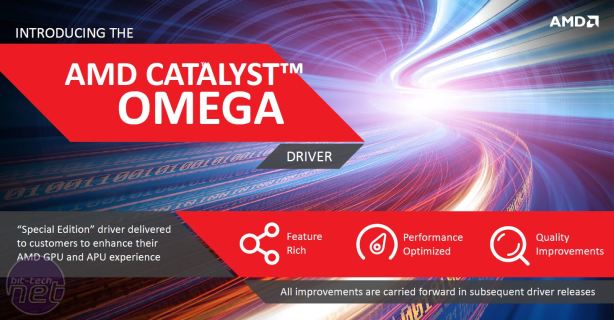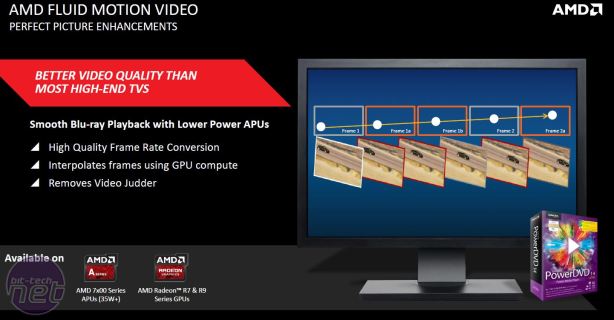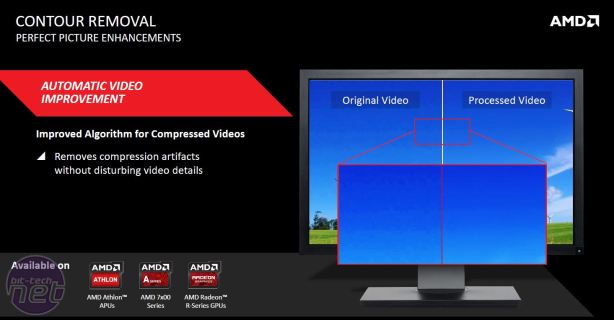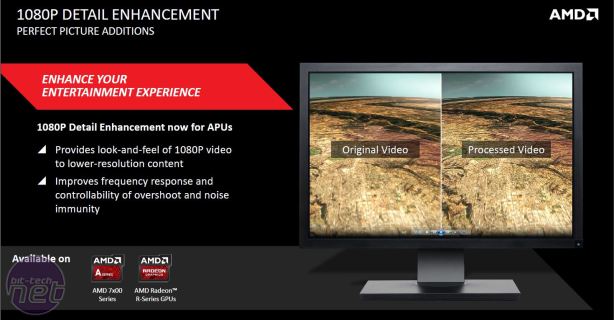AMD Launches Catalyst Omega Driver
AMD is today launching a major update to its Catalyst driver suite, know as Catalyst Omega. With no new hardware this side Christmas, AMD is using the opportunity to introduce a slew of features, performance improvements and bug fixes to its software package, with Catalyst Omega set to bring benefits to both developers and end users. AMD refers to Catalyst Omega as a Special Edition driver, but it represents a new baseline for the suite – all updates will be carried forward in future releases. Please note that this is purely a discussion piece covering the main updates at this stage, as we have yet to do testing of our own with Catalyst Omega.The headline news is that Catalyst Omega can bring about performance increases of up to 19 percent with discrete GPUs and up to 29 percent with APUs, depending of course on the hardware and software in question. However, there's much more to it than that.
Catalyst Omega brings with it some enhancements and additions to AMD's feature set for improving visual quality during video playback. The first concerns AMD Fluid Motion Video, which is now available on all 7x00 A-Series APUs (35W+) and Radeon graphics cards. FMV harnesses GPU power with compute algorithms that can be used by PowerDVD 14 to smooth out footage when converting 24Hz Blu-ray source files into 60Hz playback. It does this by computing and interpolating inferred frames rather than simply repeating existing ones, supposedly removing judder without sacrificing detail.
Contour Removal is an algorithm that affects compressed video formats by attempting to remove video artifacts, again without losing detail. According to AMD, it shouldn't be limited by file type. This is enabled by a check box in the Catalyst Control Centre (CCC).
There are also some additions with regards to upscaling content. For example, 1080p Detail Enhancement, which unsurprisingly attempts to introduce higher detail levels to low resolution content when playing at 1080p, is now available on AMD APUs (7x00 A-Series). Like Contour Removal, the various aspects of this feature (e.g. edge-enhancement, de-noise, de-blocking etc.) are enabled with check boxes in the CCC. There's also the FullHD to UltraHD feature, which does exactly what it says. It combines FMB, Detail Enhancement and adaptive upscaling to make 1080p content look better when played on a 4K display – it is enabled by default as part of the driver.
Another big announcement is something enthusiasts have been waiting patiently for, which is support for AMD's FreeSync technology on AMD FirePro, 7x00 A-Series APUs and of course Radeon R-Series desktop graphics. FreeSync uses DisplayPort's industry standard adaptive sync technology to synchronise your monitor's refresh rate to the frame rate of your content as it changes to eliminate stutter and tearing. This is similar to Nvidia's G-Sync technology, without the need for an additional scaler.
Samsung has already announced five 4K panels that will support FreeSync – like G-Sync, you'll still need a new monitor, as it needs to supports the new DisplayPort standard, but AMD estimates that FreeSync monitors will cost around $100 less than equivalent G-Sync screens. The Samsung panels announced are the UE590 (23.6-inch and 28-inch) and the UE850 (23.6-inch, 27-inch and 31.5-inch). These should be shipping in Q1 2015, with other monitors expected to be announced soon as well.
Another notable screen on the market is the Dell UP2715k, mainly because of its 5K resolution (5,120 x 2,880 to be precise). Catalyst Omega enables native support for 5K displays at 60Hz using two DisplayPort 1.2 connectors on FirePro and Radeon R-Series cards – simply connect the DisplayPorts and boot into Windows 8.1, and the screen should be auto-configured. FirePro users can also now utilise 24-screen (!) Eyefinity set-ups in Windows for the first time (previously it could be done in Linux), with six screen per GPU in a 4-way system.
AMD is also promising lot of quality assurance for Catalyst Omega. During development, it implemented a large scale driver solution across its workforce to help identify and fix as many issues as possible. It also tested the driver on more test systems and a wider range of system configurations than ever before. Finally, AMD utilised community feedback to develop a top 10 list of things that needed fixing from previous drivers and addressed them all. You can see the full list in the image above.

MSI MPG Velox 100R Chassis Review
October 14 2021 | 15:04
















Want to comment? Please log in.